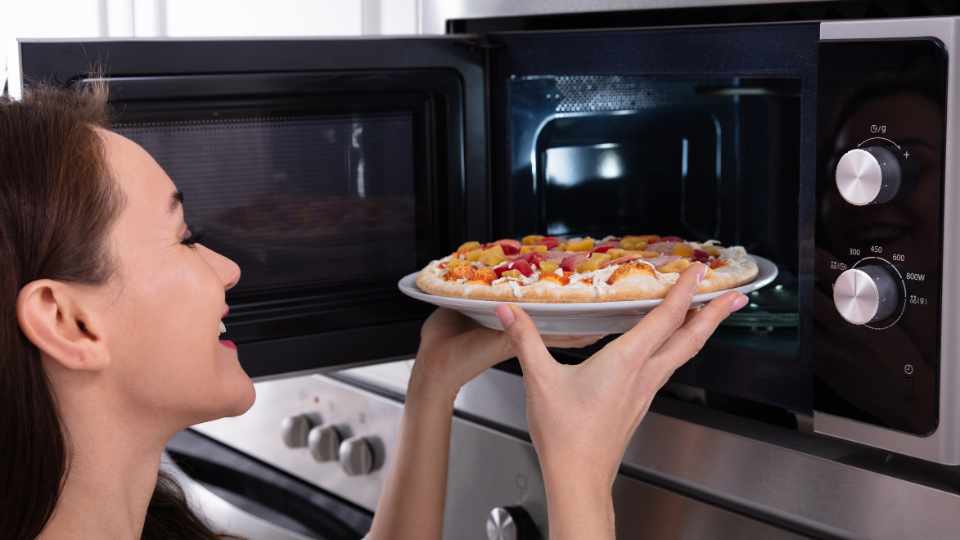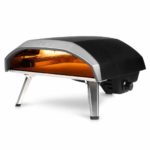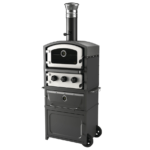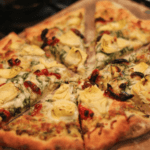How To Cook Pizza In Microwave
Are you a self-proclaimed pizza lover? Looking to cook delicious pizza without the hassle of firing up your oven? Making pizza in the microwave is an easy, fast and efficient way to get your favorite cheesy goodness.
This blog will be guided on how to make perfect pizzas in a jiffy with some simple tips and expert advice for crafting tasty and steaming hot piping pizzas straight from the microwave.
The Basics Of Cooking Pizza In A Microwave
Cooking pizza in the microwave is an easy way to enjoy a delicious and effortless pizza. To begin, you will need to prepare the dough by kneading it for several minutes until it has reached its desired texture.
Then let the dough sit out so that it can rise and ferment with yeast before being cooked.
Set your microwave on a top heat setting and preheat it for 1-2 minutes prior to placing the dough inside. By doing this step, you will ensure more even cooking throughout all areas of your pizza as well as prevent common mistakes such as overcooking or undercooking which would otherwise result in undesirable results.
Utilizing a microwavable pan or crisper is also ideal when cooking pizzas in a microwave oven since these kitchen accessories provide better air circulation aroundthe food item resultingin more evenly cooked recipes overall.
Tips And Tricks For Perfect Microwave Pizza

For a crisp and succulent pizza, brush the crust with olive oil before cooking, add toppings after letting it cook, experiment with various seasonings and sauces to mix up the flavor, and pre-cook certain ingredients if needed.
Use A Microwavable Pizza Tray Or Pizza Crisper
A microwavable pizza tray or pizza crisper is a great way to improve the quality of your microwave-cooked pizza. These accessories are designed with materials and shapes that can help achieve a crispy crust and even cooking.
The perforated surface helps to distribute heat evenly, while the raised edges stop melted cheese from spilling over during cooking. Pizza trays also ensure that any toppings don’t stick to the bottom of your microwave, for an overall better baking experience.
When using a microwavable pizza tray or crisper sheet, brush the crust lightly with olive oil before placing in microwave for added flavor and crispness. Be sure to leave some space around the edges so hot air can circulate properly while cooking on high power settings.
Brush The Crust With Olive Oil
Brushing the crust with olive oil is an important step when cooking pizza in a microwave. It helps to give the crust a crispy and golden-brown texture, and can add moisture for a better eating experience.
To brush your pizza dough with olive oil, simply use a pastry brush or paper towel to lightly coat both sides of the uncooked dough with extra virgin or pure olive oil. Make sure you evenly spread out the oil all over your pizza base before placing it in the microwave.
Add Toppings After Cooking
Adding toppings after cooking is a technique that is important to consider when microwaving pizza. When the toppings, such as vegetables and meats, are added during the cooking process they can quickly become overcooked or even burnt.
Adding them towards the end of the microwaving time will ensure that they remain nice and crunchy with all their flavours intact. This also helps to avoid issues related to soggy or soft crusts.
The intensity of microwave heat will help cook through whatever ingredients have been placed on top meaning some maybe require pre-cooking before adding them for optimal results.
Experiment With Seasonings And Sauces
When it comes to making pizza in the microwave, seasonings and sauces can have a major impact on the end result. Seasoning blends like Italian herbs, oregano, garlic powder, and basil are great for adding depth of flavor to any pizza.
When using canned tomato sauce or fresh tomatoes on your pizza make sure to add plenty of seasoning for extra flavor. Cheese melts quickly in the microwave so consider adding some grated cheese before cooking this will help to keep your pizza from drying out since there is no oven heat present.
In terms of experimenting with different flavors when making microwaved pizzas it all depends on personal preference and what type of toppings you decide to use for your base.
For traditional style pepperoni pizzas try a BBQ sauce or sweet chilli sauce as an alternative option paired with spicy seasonings such as chili flakes or paprika which helps give your dish more flavour overall.
Pre-cook Certain Ingredients
Pre-cooking certain ingredients is important when it comes to making the perfect microwave pizza, as it can significantly improve both its texture and taste. Examples of ingredients that should be pre-cooked include red or yellow peppers, mushrooms, onions and garlic.
Preheating these vegetables helps prevent sogginess in the pizza crust due to excess moisture released during cooking in a microwave as opposed to an oven. To preheat these vegetables correctly for microwaved pizzas, simply cut up the desired amount and place them on a plate lined with some kitchen paper towel before microwaving for 1 minute at 30% power setting until softened.
Additionally, pre-cooking pepperoni helps make sure it will be crispy when combined with other toppings on top of your finished pizza slice.
Finally cheese melting is critical – use only part-skim mozzarella as this melts better than full fat mozzarella cheese in comparison; also shredding cheese rather than cubing improves meltability ensuring a delicious cheesy base every time you cook your masterpiece!
Common Mistakes To Avoid
Avoiding common mistakes when cooking pizza in the microwave helps ensure that your pizza turns out perfect every time.
Overcooking Or Undercooking
Microwaving pizza can lead to a variety of results: burnt crusts, undercooked toppings, and other unappetizing outcomes. To ensure the best possible pizza experience in the microwave it is important to pay close attention and avoid overcooking or undercooking your pizza.
Sticking to proper temperature control and ensuring food safety are key components for a successful microwavable meal.
When cooking frozen pizzas in the microwave, be sure you know your wattage as this will effect how long you should heat up the pie for. Too high of heat can result in blackened cheese or an overly crisped crust; too low of heat may not cook the ingredients properly leading to foodborne illnesses such as salmonella from undercooked meats.
Start with shorter intervals at a lower setting and check often while using trial-and-error to find out what works best with your oven’s settings and type of pizza. For extra crispiness use a microwavable tray such as The Presto Pizza Crisper Tray which is designed specifically for microwaving pizzas (and other snack foods).
If you prefer sauce over cheesy toppings then brush olive oil on top before baking – this will help both get crispy faster without any burning or dryness due to further exposure in the oven.
Using A Metal Pan Or Foil
When cooking pizza in the microwave it is important to avoid using a metal pan or foil as this can have dangerous consequences. Whilst metal pans and aluminum foil can be used in an oven, they should never be used in a microwave as microwaves cannot pass through them but become absorbed by the food – potentially causing whatever object you are using to catch fire.
Using these items may also cause uneven baking due to the heat distribution problems inherent with metal objects when cooked within microwaves. Furthermore, it is important that nothing at all is put into a microwave for safety reasons; leaving empty will ensure any fire does not spread by trapping sparks inside the appliance or result in other types of damage.
Instead of using a metal pan or aluminum foil, those looking to cook pizza in the microwave should opt for ceramic dishes designed specifically for use in microwaves – regularly called ‘pizza crispers’ – since these materials allow even heat distribution which helps give your finished dish an evenly cooked, crispy base every time! Alternatively, consider investing into one of several plastic microwavable trays also made especially for pizzas, ensuring perfect results without having to worry about potential safety hazards associated with experimentation.
Ignoring The Wattage Of Your Microwave
When it comes to cooking pizza in a microwave, one of the most frequently made mistakes is not taking into account the wattage of your appliance. The wattage of your microwave can affect both the cooking time and food quality – if you’re using a recipe meant for a higher powered appliance, cooked foods can be inconsistently cooked or burned depending on how powerful yours is.
Most recipes designed for microwave use assume that you’re working with an oven between 700-1,000 Watts; so if yours is less powerful than this, expect longer cooking times and vice versa.
While knowing the wattage of your specific appliance may seem tedious at first glance, understanding its power will improve the taste of any dish you make in it significantly.
As with any form of cooking, measuring ingredients accurately is key – but when applying heat like in a microwave oven adjusting based on wattage helps ensure even cook throughout every part of your meal.
Adding Too Many Toppings
to a pizza cooked in the microwave can have significant impacts on its flavour, texture and cooking time. When making homemade pizzas, finding the right proportion of toppings to crust is important for an optimal result.
Adding too many toppings will make sure that the pizza dough doesn’t cook properly resulting in soggy dishes with overly wet topping ingredients that won’t be cooked through correctly.
Therefore it’s essential to avoid overburdening your pizza with excess toppings by concentrating flavours and pre-cooking denser topped ingredients such as beef sausage or thickly sliced onions prior to using them on your pizza.
You should also balance rich cheeses like Mozzarella against other elements like robust sauces or spicy meat such as ground beef or pepperoni so they don’t overwhelm each other while you can still enjoy a full range of different flavors without risking ruining your pizza by adding too much ‘stuff’.
Conclusion
Microwave cooking pizza is an easy and quick way to enjoy a delicious meal. With the proper tools, techniques and knowledge you can quickly make a great-tasting pizza with minimal effort.
When making microwave pizzas, it is essential to remember to follow recommended cooking times for both frozen or homemade pizzas. Use a microwavable tray or crisper for the best results, apply oil to prepare the crust perfectly, avoid adding too many ingredients so that everything cooks evenly, and pre-cook certain toppings like bacon.






